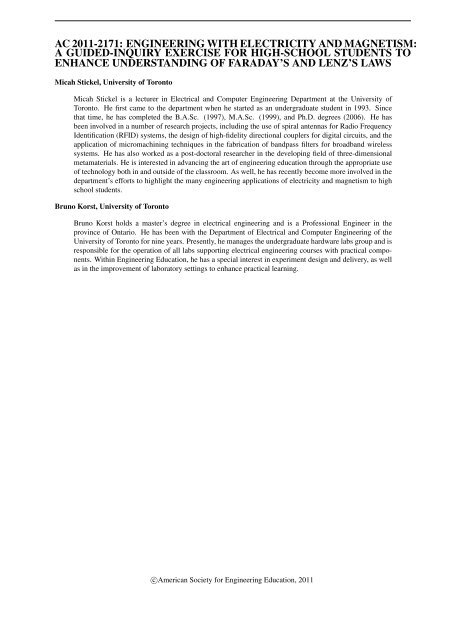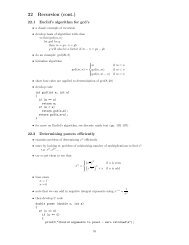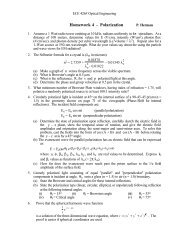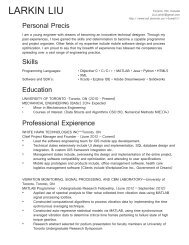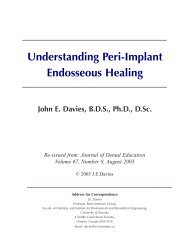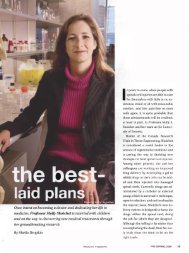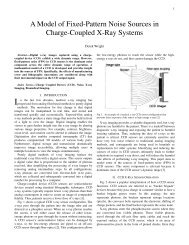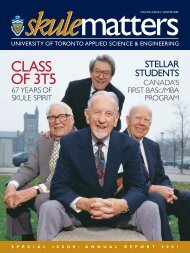Engineering with Electricity and Magnetism: A Guided-Inquiry ...
Engineering with Electricity and Magnetism: A Guided-Inquiry ...
Engineering with Electricity and Magnetism: A Guided-Inquiry ...
Create successful ePaper yourself
Turn your PDF publications into a flip-book with our unique Google optimized e-Paper software.
AC 2011-2171: ENGINEERING WITH ELECTRICITY AND MAGNETISM:<br />
A GUIDED-INQUIRY EXERCISE FOR HIGH-SCHOOL STUDENTS TO<br />
ENHANCE UNDERSTANDING OF FARADAY’S AND LENZ’S LAWS<br />
Micah Stickel, University of Toronto<br />
Micah Stickel is a lecturer in Electrical <strong>and</strong> Computer <strong>Engineering</strong> Department at the University of<br />
Toronto. He first came to the department when he started as an undergraduate student in 1993. Since<br />
that time, he has completed the B.A.Sc. (1997), M.A.Sc. (1999), <strong>and</strong> Ph.D. degrees (2006). He has<br />
been involved in a number of research projects, including the use of spiral antennas for Radio Frequency<br />
Identification (RFID) systems, the design of high-fidelity directional couplers for digital circuits, <strong>and</strong> the<br />
application of micromachining techniques in the fabrication of b<strong>and</strong>pass filters for broadb<strong>and</strong> wireless<br />
systems. He has also worked as a post-doctoral researcher in the developing field of three-dimensional<br />
metamaterials. He is interested in advancing the art of engineering education through the appropriate use<br />
of technology both in <strong>and</strong> outside of the classroom. As well, he has recently become more involved in the<br />
department’s efforts to highlight the many engineering applications of electricity <strong>and</strong> magnetism to high<br />
school students.<br />
Bruno Korst, University of Toronto<br />
Bruno Korst holds a master’s degree in electrical engineering <strong>and</strong> is a Professional Engineer in the<br />
province of Ontario. He has been <strong>with</strong> the Department of Electrical <strong>and</strong> Computer <strong>Engineering</strong> of the<br />
University of Toronto for nine years. Presently, he manages the undergraduate hardware labs group <strong>and</strong> is<br />
responsible for the operation of all labs supporting electrical engineering courses <strong>with</strong> practical components.<br />
Within <strong>Engineering</strong> Education, he has a special interest in experiment design <strong>and</strong> delivery, as well<br />
as in the improvement of laboratory settings to enhance practical learning.<br />
c○American Society for <strong>Engineering</strong> Education, 2011
<strong>Engineering</strong> <strong>with</strong> <strong>Electricity</strong> <strong>and</strong> <strong>Magnetism</strong>: A <strong>Guided</strong>-<strong>Inquiry</strong> Exercise<br />
for High-School Students to Enhance Underst<strong>and</strong>ing of<br />
Faraday’s <strong>and</strong> Lenz’s Laws<br />
Introduction<br />
Many high-school students <strong>and</strong> teachers find the concepts of Faraday’s <strong>and</strong> Lenz’s laws to be<br />
difficult to comprehend <strong>and</strong> often cannot see their relevance to our everyday lives. In many<br />
cases, these topics are omitted from the high-school curriculum or given a cursory coverage due<br />
to the teachers’ lack of comfort <strong>with</strong> this material. However, these two laws are a critical<br />
foundation for many of the key technological innovations which have taken place over the past<br />
100 years, particularly in the area of electricity generation. As such, it is important that all highschool<br />
students develop a basic comprehension of these laws <strong>and</strong> how they can be used in an<br />
engineering context.<br />
As part of the high-school outreach effort <strong>with</strong>in our Electrical <strong>and</strong> Computer <strong>Engineering</strong><br />
department, we have developed a guided-inquiry exercise which is designed to enhance the<br />
underst<strong>and</strong>ing of these two fundamental laws. This h<strong>and</strong>s-on exercise enables high-school<br />
students to discover through their own efforts the essential ideas behind these laws. At the same<br />
time, the students gain a greater appreciation for the role of engineers in society by working<br />
through the steps to solve a simple design problem.<br />
In order to share this exercise <strong>with</strong> as many students <strong>and</strong> teachers as possible we have begun to<br />
present this as a workshop to high-school teachers at regional conferences of science teachers.<br />
The primary purpose of this paper is to fully describe this h<strong>and</strong>s-on exercise <strong>and</strong> how the guidedinquiry<br />
method was implemented to highlight the most important concepts behind Faraday’s <strong>and</strong><br />
Lenz’s laws. We will also discuss the supplementary material that was prepared for the teachers,<br />
so that they would have the tools to highlight the engineering developments which have resulted<br />
from these laws. In addition, we will present some preliminary survey data that we have<br />
gathered from these conferences.<br />
Description of the Exercise on Faraday’s <strong>and</strong> Lenz’s Laws<br />
The primary purpose of this exercise was to enable high-school physics students to “discover”<br />
through direct experimentation what these laws actually mean <strong>and</strong> how they can impact society.<br />
No prior underst<strong>and</strong>ing or knowledge of these two abstract laws is assumed. The hope is that by<br />
working through this exercise before seeing the theoretical <strong>and</strong> mathematical details of these<br />
laws in class, the students will gain a greater appreciation for the practical aspect of these laws.<br />
Experimental Kit<br />
This learning experience is based around a kit which consists of a modified off-the-shelf<br />
“electromagnetic flashlight” 1 , a custom-made circuit board, <strong>and</strong> a pair of connecting wires. The<br />
components of this kit are shown in Figure 1. The flashlight was modified slightly by adding a<br />
connector to the side of the flashlight, which enabled a direct connection to one of the coils<br />
inside the body of the flashlight. The normal operation of the flashlight was not interfered <strong>with</strong>.
The flashlight serves two main purposes <strong>with</strong>in the exercise. First, it provides a simple<br />
implementation of a coil/magnet assembly for a relatively low cost (~$20), <strong>and</strong> in a package in<br />
which the movement of the magnet relative to the coil can be easily observed. Second, the<br />
flashlight illustrates how Faraday’s law can be used to solve a very practical problem, i.e., the<br />
generation of light. Since the electromagnetic flashlight is one which has no replaceable<br />
batteries in it the light created comes directly from energy generated through the shaking of the<br />
flashlight. The students can see this by using the flashlight in its normal operation.<br />
Figure 1. Components of the Experimental Kit<br />
Magnet Coils Connector<br />
The second main component of this kit is the custom-made circuit board. This board consists of<br />
two separate parts, each of which is a very simple circuit. The first circuit has a connector<br />
attached to a green light-emitting diode (LED). Thus, by using the connecting wire these<br />
students can directly connect the coil in the flashlight to this green LED. The second circuit also<br />
consists of a connector <strong>and</strong> an LED (red in this case), but it also includes a few other components<br />
(a capacitor <strong>and</strong> a diode/resistor combination which acts as a rectifying circuit). Anyone<br />
interested in the parts list <strong>and</strong> schematic of these circuits can contact the authors for this<br />
information.<br />
Guide-<strong>Inquiry</strong> Experiments<br />
Pair of wires, <strong>with</strong><br />
bare ends<br />
Electronic Circuit<br />
Board<br />
With the kit as the foundation, the exercise makes use of the discovery method as a teaching tool<br />
which allows the students to develop their own descriptions of these two fundamental laws. The<br />
plan is that each group of students is provided <strong>with</strong> a guided-inquiry framework through a set of<br />
three experiments. These experiments are described in Table 1, <strong>and</strong> the worksheets along <strong>with</strong><br />
the answer key are presented in Appendix A. Anyone interested in using these exercises in class<br />
can contact the authors to receive a softcopy of the blank worksheets.<br />
By working through each of these experiments, students are encouraged to put their own words<br />
to their observations <strong>and</strong> thus develop statements of Faraday’s <strong>and</strong> Lenz’s laws through their<br />
own efforts. This is a proven technique for improving their underst<strong>and</strong>ing <strong>and</strong> retention of the<br />
core concepts, <strong>and</strong> their motivation to learn more 2, 3 .
Table 1. The Three <strong>Guided</strong>-<strong>Inquiry</strong> Experiments to Discover Faraday’s <strong>and</strong> Lenz’s Laws<br />
Experiment Basic Steps Main Conclusions<br />
Experiment #1<br />
The Great<br />
Energy<br />
Converter<br />
(Discover the<br />
basics ideas<br />
behind<br />
Faraday’s law)<br />
Experiment #2<br />
Let’s Do Some<br />
<strong>Engineering</strong><br />
(Make use of<br />
Faraday’s law<br />
to solve an<br />
engineering<br />
design problem<br />
based around<br />
the generation<br />
of “light”<br />
energy)<br />
Experiment #3<br />
No Free<br />
Energy Here<br />
(Discover the<br />
basic ideas<br />
behind Lenz’s<br />
law)<br />
• Connect the coil of the flashlight to<br />
the green LED on the circuit board.<br />
• Shake the flashlight <strong>and</strong> observe<br />
what happens <strong>with</strong> the green LED.<br />
• Consider what is required for the<br />
LED to light up.<br />
• Come up <strong>with</strong> a statement<br />
concluding your observations.<br />
• Discuss why the situation of<br />
Experiment #1 would not lead to a<br />
very practical “flashlight”.<br />
• Come up <strong>with</strong> a plan of how to<br />
improve the “usability” of this<br />
“flashlight” design.<br />
• Connect the coil of the flashlight to<br />
the second circuit on the circuit<br />
board (the one <strong>with</strong> the red LED),<br />
<strong>and</strong> shake the flashlight again.<br />
• Determine the main purpose for<br />
this second circuit, <strong>and</strong> how does<br />
this relate to the plan that you came<br />
up <strong>with</strong> to improve the<br />
“flashlight’s” usability.<br />
• Disconnect the coil from the circuit<br />
board.<br />
• Shake the flashlight for two cases<br />
(a) connect the two wires of the<br />
coil together, <strong>and</strong> (b) disconnect<br />
the two wires of the coil from each<br />
other.<br />
• Observe the classroom<br />
demonstration involving an<br />
oscillating magnet 4 .<br />
• Relate these observations to the<br />
description of Faraday’s law that<br />
you developed in Experiment #1.<br />
• Consider how this relates to the<br />
conservation of energy.<br />
• The rate at which the LED turns on<br />
relates to how quickly the flashlight is<br />
shaken.<br />
• This means that kinetic energy is<br />
converted to “light” energy.<br />
• Since an LED requires a flow of<br />
electrical charges to produce a light,<br />
one can conclude that the movement of<br />
the magnet through a coil creates a flow<br />
of electrical charges through the LED<br />
(simple statement of Faraday’s law).<br />
• Since the LED lights only <strong>with</strong> the<br />
magnet moves through the coil,<br />
constant motion is required for a<br />
continuous light source. This makes it<br />
impossible to direct the light to a<br />
specific area.<br />
• To improve this design, one needs to<br />
store the energy generated by the<br />
magnet moving through the coil.<br />
• The purpose of the second circuit is to<br />
store this electrical energy generated<br />
through the movement of the magnet<br />
through the coil<br />
• When the coil wires are connected<br />
together the overall displacement of the<br />
magnet <strong>with</strong>in the coil is less than when<br />
the coil wires are disconnected<br />
• This lack of displacement when the coil<br />
wires are connected together indicate<br />
that the electrical current generated by<br />
the moving magnet through the coil<br />
creates its own magnet field that<br />
opposes the movement of the magnet<br />
(simple statement of Lenz’s law).<br />
• Lenz’s law is simply a restatement of<br />
the law of conservation of energy.
Science Teacher’s Workshop Presentation<br />
This guided-inquiry exercise was first developed as an aid for high-school physics teachers in<br />
teaching these abstract concepts as part of their Grade 11 Physics curriculum. To disseminate<br />
this learning exercise to as many students as possible it has been presented as a workshop at two<br />
regional conferences for high-school science teachers. Every workshop attendee was given a kit<br />
which they could take back to their class to use as a demonstration model. This model could be<br />
quite easily replicated for larger classes, or could be shared amongst a number of groups of<br />
students as they work through the experiments.<br />
The workshop was run in a similar manner to how the actual exercise would be used in class, so<br />
that the teachers had an idea of what their students would be experiencing. In addition, some of<br />
the finer details were also discussed. This included: (a) how these observations <strong>and</strong> conclusions<br />
related to the mathematical representations of these laws (something which was not expected<br />
from the students), (b) the part list <strong>and</strong> theory behind the second energy-storage circuit on the<br />
circuit board, <strong>and</strong> (c) the actual operation of the LED.<br />
Since one of the purposes for this exercise was to give the students a greater sense of what<br />
electrical engineering is about, there was also some discussion in the workshop on related<br />
applications of Faraday’s <strong>and</strong> Lenz’s laws <strong>with</strong>in society. As well, a brief discussion of<br />
electrical energy storage was presented since this was the main tool used to solve the engineering<br />
design problem <strong>with</strong>in this exercise. A set of additional notes that included more details about<br />
these applications <strong>and</strong> other suggested classroom demonstrations for each topic was also given to<br />
the high-school teachers. These notes are presented in Appendix B.<br />
Workshop Participant Survey Results<br />
At the end of the most recent workshop, presented in the fall of 2010, a survey was administered.<br />
Twenty-two of the 30 participants completed the survey <strong>and</strong> the results are summarized in Table<br />
2. Overall, the workshop attendees were quite positive about their workshop experience, <strong>with</strong> all<br />
of them agreeing that the workshop was an enjoyable experience. The teachers seemed to be<br />
quite enthusiastic about incorporating real-life applications of Faraday’s <strong>and</strong> Lenz’s laws into<br />
their classroom (77% strongly agreeing <strong>with</strong> this statement), <strong>and</strong> many of them (68%) indicated<br />
that they plan to provide their students <strong>with</strong> an experience of how these laws can be used to solve<br />
an engineering design problem. As well, 77% stated that they strongly agreed <strong>with</strong> the notion of<br />
helping their students to better underst<strong>and</strong> the role of the electrical engineer <strong>with</strong>in society.<br />
Also, from these results it seems that for about half of the attendees, the workshop helped to<br />
increase their underst<strong>and</strong>ing of these two laws. This may be partly because many of them<br />
already came into the workshop quite comfortable <strong>with</strong> these concepts. Indeed the workshop<br />
seemed to attract a rather wide range of teachers, some that had taught physics for many years<br />
<strong>and</strong> some that were fairly new to teaching this subject.
Table 2. Workshop Attendee Survey Results (22 respondents)<br />
Question<br />
Overall, I found this workshop to be<br />
quite enjoyable.<br />
This workshop has increased my<br />
underst<strong>and</strong>ing of Faraday’s law <strong>and</strong><br />
Lenz’s law.<br />
This workshop has enhanced my<br />
appreciation for how a capacitor can<br />
be used as an electrical energy<br />
storage device.<br />
This workshop has enhanced my<br />
appreciation for how basic<br />
engineering principles can be<br />
applied to solve a societal problem<br />
using Faraday’s law.<br />
Based on this workshop, I plan to<br />
incorporate more real-life<br />
applications into my classes on<br />
Faraday’s law <strong>and</strong> Lenz’s law.<br />
Based on this workshop, I plan to<br />
provide my students <strong>with</strong> an<br />
experience in which they can use<br />
Faraday’s law <strong>and</strong> Lenz’s law to<br />
“engineer” a solution to a problem.<br />
Based on this workshop, I plan to<br />
help my students better underst<strong>and</strong><br />
the role of the electrical engineer in<br />
society.<br />
Attendee Response<br />
(5 – Strongly Agree, 4 – Somewhat Agree,<br />
3 – Neutral, 2 – Somewhat Disagree,<br />
1 – Strongly Disagree)<br />
Strongly Agree 91%<br />
Somewhat Agree 9%<br />
Neutral 0%<br />
Somewhat Disagree 0%<br />
Strongly Disagree 0%<br />
Strongly Agree 50%<br />
Somewhat Agree 41%<br />
Neutral 9%<br />
Somewhat Disagree 0%<br />
Strongly Disagree 0%<br />
Strongly Agree 41%<br />
Somewhat Agree 50%<br />
Neutral 9%<br />
Somewhat Disagree 0%<br />
Strongly Disagree 0%<br />
Strongly Agree 64%<br />
Somewhat Agree 32%<br />
Neutral 4%<br />
Somewhat Disagree 0%<br />
Strongly Disagree 0%<br />
Strongly Agree 77%<br />
Somewhat Agree 18%<br />
Neutral 5%<br />
Somewhat Disagree 0%<br />
Strongly Disagree 0%<br />
Strongly Agree 68%<br />
Somewhat Agree 27%<br />
Neutral 5%<br />
Somewhat Disagree 0%<br />
Strongly Disagree 0%<br />
Strongly Agree 77%<br />
Somewhat Agree 9%<br />
Neutral 14%<br />
Somewhat Disagree 0%<br />
Strongly Disagree 0%<br />
Question<br />
Average<br />
4.91<br />
4.41<br />
4.32<br />
4.59<br />
4.73<br />
4.64<br />
4.64
In order to assess if these teachers have actually incorporated this engineering exercise into their<br />
classroom <strong>and</strong> if it was a successful experience, a follow-up survey will be administered later<br />
this year. To assess the ultimate goals of the exercise will require direct interaction <strong>with</strong> the<br />
high-school students who work through this exercise. This interaction could be a combination of<br />
student surveys, observations of the students working through the exercise, <strong>and</strong> interviews <strong>with</strong><br />
the students. The outst<strong>and</strong>ing research questions associated <strong>with</strong> this project are:<br />
(a) Do high-school students develop a greater underst<strong>and</strong>ing of Faraday’s <strong>and</strong> Lenz’s laws<br />
through the completion of this exercise?<br />
(b) Is their underst<strong>and</strong>ing of these laws impacted by the timing of this exercise? Meaning<br />
does it matter if it is done prior to or after a theoretical presentation of the material?<br />
(c) Do high-school students develop a greater underst<strong>and</strong>ing of how Faraday’s <strong>and</strong> Lenz’s<br />
laws can be used to solve engineering problems?<br />
(d) Do high-school teachers find that the workshop <strong>and</strong> supplemental materials provide them<br />
<strong>with</strong> enough support to implement this exercise into their classroom?<br />
(e) Do high-school teachers find that incorporating this exercise into their classroom enables<br />
them to provide the students <strong>with</strong> a greater underst<strong>and</strong>ing of the role of electrical<br />
engineers <strong>with</strong>in society?<br />
Conclusions<br />
A new guided-inquiry exercise has been developed to enable the better underst<strong>and</strong>ing of<br />
Faraday’s <strong>and</strong> Lenz’s laws at the high school level. The exercise allows the students to come up<br />
<strong>with</strong> their own statements of these fundamental laws through their observations from a set of<br />
three experiments. Through the use of the discovery method, it is hoped that this exercise gives<br />
the students a more substantial learning experience than they would have had <strong>with</strong> traditional<br />
classroom teaching.<br />
The exercise is based upon experiments using a custom developed kit <strong>with</strong> the main component<br />
being an electromagnetic flashlight. The set of experiments are designed so that the students can<br />
discover these laws as well as solve an engineering design problem in the process. This design<br />
experience provides the students <strong>and</strong> the teacher <strong>with</strong> the opportunity to discuss in greater detail<br />
the role of the electrical engineer <strong>with</strong>in society.<br />
In an effort to disseminate this exercise to as many high-school students as possible, this exercise<br />
has been presented at two regional conferences for high-school science teachers. Survey results<br />
from 22 attendees at the most recent of these conferences indicate that the teachers found the<br />
workshop <strong>and</strong> the exercise to be quite beneficial in developing their underst<strong>and</strong>ing of these laws<br />
<strong>and</strong> in highlighting how Faraday’s law can be used to solve practical problems <strong>with</strong>in society.<br />
Indeed, 91% of the respondents agreed that the workshop helped to increase their underst<strong>and</strong>ing<br />
of these laws, <strong>and</strong> 96% agreed that the workshop enhanced their appreciation for how basic<br />
engineering principles can be applied to solve a societal problem using Faraday’s law. These are<br />
good signs that this workshop has made a positive impact <strong>with</strong> the attendees <strong>and</strong> that this<br />
exercise has the potential to translate into successful learning experiences for their students.
Bibliography<br />
1. Noma LED Shake Flashlight, product # 65-2050-4.<br />
2. Hermann, G., “Learning by Discovery: A Critical Review of Studies,” The Journal of Experimental Education,<br />
Vol. 38, No. 1, 1969, pp. 58-72.<br />
3. McKeachie, W. J., <strong>and</strong> Svinicki, M., McKeachie’s Teaching Tips: Strategies, Research, <strong>and</strong> Theory for<br />
College <strong>and</strong> University Teachers, 12 ed., Houghton Mifflin, New York, NY, 2006.<br />
5. Nilson., L. B., Teaching at its Best: A Research-Based Resource for College Instructors, 2 ed., Jossey-Bass,<br />
San Francisco, CA, 2003.<br />
4. Oscillating Magnets in Coupled Coils, U.C. Berkeley Physics Lecture Demonstrations, available at<br />
http://www.mip.berkeley.edu/physics/physics.html, Accessed January 18 th , 2011.
Appendix A: <strong>Guided</strong>-<strong>Inquiry</strong> Experiments on Faraday’s <strong>and</strong> Lenz’s Law <strong>with</strong> Answer Key<br />
Experiment #1 – The Great Energy Converter<br />
In this experiment, you will discover the law of physics which is responsible for nearly all of the<br />
electricity generation <strong>with</strong>in our society. If it had not been for the great electrical engineers<br />
that first applied this law our world would be unrecognizable.<br />
Exercise 1.1<br />
1) Using the pair of wires, connect the flashlight to the green light emitting diode (LED) on<br />
the electronics board (Circuit #1).<br />
2) Complete the following tasks <strong>and</strong> record your observations in the table below. Compare<br />
your results <strong>with</strong> those of the person to your left.<br />
Task<br />
Shake the flashlight slowly<br />
Shake the flashlight quickly<br />
Observations<br />
o As the flashlight is shaken the green LED lights up.<br />
o In other words, the LED lights up as the magnet moves<br />
through the coil.<br />
o As the flashlight is shaken faster the LED flashes<br />
quicker.<br />
o Each time the magnet passes through the coil the LED<br />
flashes once.<br />
Question 1.1:<br />
Clearly there must be energy coming from somewhere since the LED lights up. With your<br />
partner, pair up <strong>with</strong> the two people to your left. As a group, determine what is the source of<br />
this energy?<br />
o It has been observed that the movement of the magnet through the coil causes<br />
the LED to light. Therefore, it can be concluded that it is the mechanical motion<br />
of shaking the flashlight that is the source of the energy. This kinetic energy is<br />
converted into light energy. This kinetic energy comes from the contraction of<br />
the muscles which are powered by the food that has been eaten. Ultimately, this<br />
energy has its source in the sun.
Experiment #1 – The Great Energy Converter (continued)<br />
Question 1.2:<br />
The fundamental requirement for an LED to light up is the same as that for a regular lightbulb.<br />
Given this, work <strong>with</strong> your partner to determine what is this fundamental requirement?<br />
o In order to light up an LED or a lightbulb an electrical current is required to flow<br />
through them. This means that electrons must be “pushed” through the LED or<br />
lightbulb by some source of electricity. For example, this source could be a<br />
battery.<br />
Question 1.3:<br />
If we told you that the observations from this exercise are due to something that we call<br />
“Faraday’s Law”, how would you describe this “law”? Come up <strong>with</strong> your own description <strong>and</strong><br />
then discuss this <strong>with</strong> your partner.<br />
o The main observation was:<br />
Each time the magnet moves through the coil the LED lights up.<br />
o Since the LED requires electrical current to flow through it to light up, we can say<br />
that “Faraday’s Law” could be:<br />
“When a magnet moves through a closed coil, an electric current is<br />
created. This is called an induced current”<br />
Experiment #2 – Let’s Do Some <strong>Engineering</strong><br />
In this experiment you will have some experience in what an electrical engineer does. First, you<br />
must identify the problem to be solved. Second, you must figure out a solution which both<br />
solves the problem <strong>and</strong> is realistic, meaning that it can be built.<br />
Question 2.1:<br />
Let us consider the main observation of Experiment #1 in greater detail. For the situation of<br />
Experiment #1, in which the coil was directly connected to the LED, explain why this type of<br />
“flashlight” would be of no practical use.<br />
o Since the LED flashes only when the magnet moves through the coil, the<br />
flashlight would have to be continually shaken to produce a steady beam of light.<br />
o This means that we would have very little control over where the beam of light<br />
was directed, which would make this “flashlight” of little practical use.
Experiment #2 – Let’s Do Some <strong>Engineering</strong> (continued)<br />
Question 2.2:<br />
Now put on your electrical engineering hats. As a group of four, come up <strong>with</strong> a plan to<br />
improve the “usability” of this “flashlight”?<br />
o The main goal would be to create a flashlight that provides a steady beam of<br />
light for as long as possible. This would be our design specification.<br />
o To meet this specification, we need a way to store the electrical energy<br />
generated by the movement of the magnet through the coil.<br />
o This means that we need to add to our flashlight an electrical energy storage<br />
device.<br />
Exercise 2.1:<br />
Prior to this workshop, we have done a little electrical engineering ourselves <strong>and</strong> came up <strong>with</strong><br />
our own plan, or design, to make this “flashlight” usable. Test out our design by:<br />
1) Disconnecting the flashlight from Circuit #1 <strong>and</strong> connecting it to Circuit #2 (the blue<br />
connector on the electronic circuit board). Recall, that the red LED is identical to the<br />
green LED in Circuit #1, it just has a different colour.<br />
2) Slowly shake the flashlight. How does the performance of this flashlight design compare<br />
<strong>with</strong> the “flashlight” design of Experiment #1? Record your observations in the table<br />
below, <strong>and</strong> compare these <strong>with</strong> your partner.<br />
Observations<br />
o For this design, the red LED does not flash, but stays lit for a much<br />
longer period of time (approximately 15 seconds).<br />
Question 2.3:<br />
With your partner, determine the fundamental purpose of Circuit #2, <strong>and</strong> discuss any other<br />
options for storing the electrical energy that is generated as the magnet moves through the<br />
coil?<br />
o The purpose is to act as an electrical energy storage device<br />
o The largest piece in this circuit is a 1000 µF capacitor which stores the electrical energy<br />
o The other three pieces of the circuit (not including the LED) are there to ensure that the<br />
capacitor properly stores <strong>and</strong> then releases its energy.<br />
o One other option for storing electrical energy would be to use a rechargeable battery. In<br />
fact, this is the technique that is used in the flashlight that you have been given.
Experiment #3 – No Free Energy Here<br />
This experiment is focused on Lenz’s law, which is closely related to Faraday’s law. You will see<br />
that if this law did not exist, the world would behave in a very strange way.<br />
Exercise 3.1:<br />
1) Disconnect the wires from the electronics board.<br />
2) Complete the following tasks <strong>and</strong> record your observations in the table below. Compare<br />
your results <strong>with</strong> those of your partner.<br />
Task<br />
Hold the flashlight horizontally <strong>and</strong> slowly<br />
shake it back <strong>and</strong> forth. Make sure that<br />
the two bare ends of the wires are not<br />
touching each other. How far does the<br />
magnet move?<br />
Hold the two bare ends of the wires<br />
together such that they are well<br />
connected to each other. Again, slowly<br />
shake the flashlight horizontally <strong>and</strong><br />
observe the movement of the magnet.<br />
Try to replicate the same strength of<br />
shaking as you did for the first task in this<br />
exercise. How far does the magnet move<br />
for this case?<br />
Consider the demonstration that was<br />
shown. What are your main observations<br />
for the cases in which the coil is not<br />
connected to itself, <strong>and</strong> when it is<br />
connected to itself (“shorted out”)?<br />
Observations<br />
Experiment Case #1: Wires not connected together (coil open)<br />
o About one-half of the magnet exits the coils both at the top<br />
<strong>and</strong> the bottom as the magnet is shaken.<br />
Experiment Case #2: Wires connected together (coil closed)<br />
o The magnet is now not visible at all as it moves. None of it<br />
exits the coil either at the top or at the bottom.<br />
Demonstration Case #1: Coil not connected to itself<br />
o The magnet on the spring moves up <strong>and</strong> down freely <strong>with</strong>in<br />
the coil.<br />
o It moves up <strong>and</strong> down approximately 20 times before it<br />
stops moving.<br />
Demonstration Case #2: Coil connected to itself (“shorted out”)<br />
o The magnet on the spring moves up <strong>and</strong> down only a few<br />
times before it stops moving.
Experiment #3 – No Free Energy Here (continued)<br />
Question 3.1:<br />
With your partner, determine how this relates to Faraday’s law. In particular, use Faraday’s law<br />
to explain the difference in your observations for the two cases. Recall, that Faraday’s law as<br />
we have discovered it can be stated as:<br />
“When a magnet moves through a closed coil, an electric current is<br />
created. This is called an induced current”<br />
o Since there is a magnet moving in a coil, an electric current can flow. However, for an<br />
electric current to flow there must be a closed conducting path.<br />
o This means that for the case where the coil is not connected to itself there is no induced<br />
current that flows (the coil is open).<br />
o For the case where the coil is shorted out, there is an induced current that flows. Recall,<br />
that ever current has a magnetic field, so this induced current has its own “induced<br />
magnetic field”.<br />
o Since the magnet slows down when the coil is shorted, this shows that the induced<br />
magnetic field opposes the magnetic field of the moving magnet.<br />
o In effect, when the coil is shorted out there is a “braking effect” on the magnet.<br />
o This is the essence of Lenz’s law. It can be stated as:<br />
“The magnetic field that is induced, or created, by a magnet moving through a closed<br />
coil will always act in opposition to the original magnetic field of the magnet”<br />
Question 3.3:<br />
Suppose that we lived in an alternate universe in which we repeated this same demonstration.<br />
In this alternate universe the observations for this same demonstration were:<br />
(a) For the case of where the coil was not connected to itself, the magnet moved freely<br />
<strong>and</strong> moved up <strong>and</strong> down about 20 times before coming to a stop.<br />
(b) For the case of where coil was shorted out, the magnet moved up <strong>and</strong> down <strong>with</strong><br />
increasing speed <strong>and</strong> never came to a stop.<br />
As a group of four, discuss which fundamental law of physics these observations (<strong>and</strong> thus this<br />
alternate universe) violate?<br />
o Given these observations there is no longer a braking effect on the magnet by the<br />
induced magnetic field, but instead the movement of the magnet is increased by the<br />
induced magnetic field.<br />
o Considering the energy in the system, there is a small amount of potential energy at the<br />
start when the spring is stretched. As the magnet moves, there appears to be a limitless<br />
supply of kinetic energy since the magnet never stops. This violates the conservation of<br />
energy since there turns out to be more kinetic energy than there was potential energy.<br />
o This shows us that Lenz’s law is essentially just a restatement of the law of conservation<br />
of energy.
Appendix B: Additional Material Given to Workshop Participants<br />
Additional Material<br />
Electrical <strong>and</strong> computer engineering (ECE) is a very exciting branch of applied science <strong>and</strong><br />
engineering as it covers a wide range of applications. The heart of ECE is focused around the<br />
harnessing of electricity to solve society’s problems <strong>and</strong> improve the world we live in. This<br />
could involve the development of highly efficient solar energy collectors, the design of complex<br />
software systems which can improve the functionality of wireless communications, or the control<br />
of unmanned vehicles such as airplanes or cars. Each area in which electrical <strong>and</strong> computer<br />
engineers work requires a strong underst<strong>and</strong>ing of the fundamental mathematics <strong>and</strong> sciences,<br />
such as electricity <strong>and</strong> magnetism.<br />
We hope that this additional material will add to the different aspects of electrical <strong>and</strong> computer<br />
engineering that you bring into your classroom. We have tried to highlight some of the most<br />
interesting <strong>and</strong> relevant engineering applications of the main topics of this workshop, namely<br />
Faraday’s law, Lenz’s law, <strong>and</strong> Electrical Energy Storage (Capacitors).<br />
Faraday’s Law<br />
Summary<br />
During the workshop we have determined that Faraday’s law can be stated as:<br />
“When a magnet moves through a closed coil, an electric current is<br />
created. This is called an induced current”<br />
In more general terms we can state Faraday’s law as:<br />
“When a magnetic field changes in the presence of a conducting material,<br />
an electric current is induced in the conducting material.”<br />
This means there are two main components to Faraday’s law:<br />
1) A changing magnetic field. The change can be caused by:<br />
a. The relative movement between a permanent magnet <strong>and</strong> the<br />
conducting material, <strong>and</strong>/or,<br />
b. The time variation of a source current, i.e., an AC current, which has<br />
its own time-varying magnetic field.<br />
2) A conducting material.<br />
a. If the conducting material forms a closed path, then an induced current<br />
can flow in the material which results in an opposing induced<br />
magnetic field.<br />
b. If the conducting material does not form a close path (e.g., a ring <strong>with</strong><br />
a slit cut into it) then an induced current cannot flow <strong>and</strong> there is no<br />
opposing induced magnetic field.
Faraday’s Law (continued)<br />
<strong>Engineering</strong> Applications<br />
There are now innumerable ways in which engineers have applied Faraday’s law to solve major<br />
engineering problems over the last century. Many examples can be found at the Wikipedia page<br />
on Electromagnetic Induction, http://en.wikipedia.org/wiki/Electromagnetic_induction<br />
Some of the most important <strong>and</strong> current applications are:<br />
1) <strong>Electricity</strong> Generation<br />
The vast majority of our electricity generation comes through the conversion<br />
mechanical energy to electrical energy. The<br />
mechanical energy is a result of the turning of large<br />
turbines through:<br />
a) The flow of water (hydroelectric dams or tidal<br />
power)<br />
b) The steam created through nuclear fission or<br />
the burning of fossil fuels (nuclear <strong>and</strong> coalfired<br />
power plants)<br />
c) The flow of air (wind turbines)<br />
The part of these turbines consist of a magnetic field, that changes through the<br />
mechanical rotation, <strong>and</strong> a set of conducting coils in which the induced current<br />
exists.<br />
2) Credit <strong>and</strong> Debit Card Readers <strong>and</strong> Computer Hard Drives<br />
• Most credit <strong>and</strong> debit cards have the user’s information<br />
“written” into the magnetic stripe on the back of the<br />
card.<br />
• This stripe acts as a set of small “permanent magnets”.<br />
• As the card is swiped through a reader, there is a<br />
changing magnetic field in the presence of a conducting<br />
material, since these small “permanent magnets” are<br />
being moved past a conducting loop in the reader.<br />
• The induced current in the conducting loop can be<br />
“interpreted”, which results in the card’s information<br />
being “read”.<br />
• A very similar process is at the heart of how data is<br />
stored in computer hard drives.
Faraday’s Law (continued)<br />
3) Electrical Transformers<br />
• These devices consist of:<br />
a) One coil (the primary) that carries an AC current,<br />
which creates a changing magnetic field.<br />
b) This changing magnetic field interacts <strong>with</strong> the<br />
second coil (the secondary), which will have an<br />
induced current flowing through it as a result of<br />
Faraday’s law.<br />
c) By adjusting the number of turns in the two coils you<br />
can create either step-up (voltage across the second<br />
coil is larger than the voltage across the first coil) or step-down<br />
(voltage across the second coil is smaller than the voltage across the<br />
first coil) transformers.<br />
Possible Classroom Demonstration<br />
Oscillating Magnets<br />
• These devices are extremely useful in a wide variety of applications, such as<br />
stepping down the high voltages that are distributed by the power companies<br />
before the electricity enters residential units.<br />
Source: U.C. Berkeley Physics Lecture Demonstrations, available at<br />
http://www.mip.berkeley.edu/physics/physics.html
Faraday’s Law (continued)<br />
This is a great demonstration which is relatively simple to put together. The<br />
magnets can be easily connected to the springs by using small metal nuts (from<br />
extra bolts lying around). Even moderately strong magnets (e.g., alnico bar<br />
magnets) <strong>with</strong> coils, or solenoids, that have a reasonable number of turns (>400<br />
turns) can demonstrate the main effect.<br />
The reason why this is such a useful demonstration is that it illustrates the two<br />
most powerful applications of Faraday’s law in today’s society: electricity<br />
generation <strong>and</strong> the motor principle. As the first magnet is moved in Coil A, the<br />
mechanical energy is converted into electrical energy through the power of<br />
electromagnetic induction. As this electrical energy is transferred to Coil B, this<br />
is converted back into mechanical energy which causes the second magnetic to<br />
move up <strong>and</strong> down. All this is done through the “invisible” <strong>and</strong> “mysterious”<br />
nature of the magnetic fields.<br />
Lenz’s law can also be qualitatively demonstrated by reversing the orientation of<br />
one of the magnets, meaning that you connect the other end of one of the magnets<br />
to the spring. For one orientation, the magnets will oscillate together. For the<br />
other orientation the magnets will oscillate opposite to each other. This<br />
demonstrates that the “type”, or orientation of magnetic field that is induced<br />
depends on the orientation of the original magnetic field.<br />
Lenz’s Law<br />
Summary<br />
There is a peculiar nature about the qualitative form of Faraday’s law, which is the one<br />
that we have developed in this workshop. It tells us that a magnetic field will be induced<br />
in a conducting material if a changing magnetic field is present, but it does not tell us<br />
how this induced magnetic field will be oriented. Indeed, there is an ambiguity about this<br />
in that the field could either be “up” or “down”.<br />
Lenz’s law is the addendum to Faraday’s law that resolves this ambiguity. During the<br />
workshop we concluded that Lenz’s law can be stated as:<br />
“The magnetic field that is induced, or created, by a magnet moving through a closed<br />
coil will always act in opposition to the original magnetic field of the magnet”<br />
Upon closer examination one can see that this is simply just a restatement of the law of<br />
conservation of energy. For example, if the induced magnetic field was oriented such<br />
that it did not oppose the original magnetic field it would be quite easy to build a device<br />
which would produce perpetual motion given a small initial impulse.
Lenz’s Law (continued)<br />
<strong>Engineering</strong> Applications<br />
The following applications are essential applications of Faraday’s law, but they rely on the<br />
specific results of Lenz’s law:<br />
1) Electromagnetic Brakes<br />
The braking effect which results from Faraday’s <strong>and</strong> Lenz’s<br />
law has been put to great use to slow down different types of<br />
vehicles. Streetcars, roller coasters, <strong>and</strong> trains have all made<br />
use of these types of brakes, as have certain types of<br />
stationary bicycles.<br />
In these brakes, a magnetic field is applied to a spinning metal<br />
disk which is attached to the axel of the vehicle. As this<br />
metal disk spins, it “sees” a changing magnetic field which<br />
causes an opposing induced magnetic field to be created.<br />
This is the source of the braking result <strong>with</strong>out any physical<br />
contact. The kinetic energy is converted into heat as the<br />
induced current flows through the resistive conducting material.<br />
See http://en.wikipedia.org/wiki/Eddy_current_brake for more details.<br />
2) Magnetically Levitated Trains (MagLev Trains)<br />
The opposing nature of the induced<br />
magnetic field can be used to levitate<br />
objects (see the Jumping Ring<br />
demonstration below). This has been<br />
used in a dramatic way in<br />
magnetically levitated (MagLev)<br />
trains.<br />
In one type of MagLev train design, a<br />
magnetic field is generated by an<br />
electromagnet on the train <strong>and</strong> this field induces an opposing induced magnetic<br />
field in coils placed in the track below the train. This opposition between the<br />
induced <strong>and</strong> original fields is what lifts this multi-tonne vehicle off the tracks.<br />
Since there is no friction between the train <strong>and</strong> the rails, these trains can travel<br />
extremely fast, <strong>with</strong> a current speed record of 581 km/h. The main limitation on<br />
the speed of the train comes from air resistance.<br />
An interesting video of a MagLev model train can be seen at:<br />
http://www.youtube.com/watch?v=TeS_U9qFg7Y. In this video the levitation is<br />
due to the properties of superconducting materials, rather than induced magnetic<br />
fields. However, it is interesting because it demonstrates the possibilities of this<br />
mode of transport.
Lenz’s Law (continued)<br />
Possible Classroom Demonstration<br />
Falling Magnets<br />
Below are two variants of the same type of demonstration. In both cases, the<br />
braking effect of the induced magnetic field can be observed. In these<br />
demonstrations:<br />
a) The falling magnet produces the changing magnetic field that is<br />
required to create an induced current.<br />
b) The induced current will only exist in conducting materials such as<br />
copper or aluminum.<br />
c) Therefore, the induced magnetic field which opposed the original field<br />
of the magnet will only exist for the cases in which the magnet falls<br />
near a conducting material. This means that the plastic rod or tube has<br />
no effect on the falling magnet.<br />
d) Since copper is a better conductor than aluminum, the current induced<br />
in the copper rod or tube is stronger. This means that the braking<br />
effect on the magnet will also be stronger for the copper than it will be<br />
for the aluminum.
Additional Resources<br />
Sources: U.C. Berkeley Physics Lecture Demonstrations, available at<br />
http://www.mip.berkeley.edu/physics/physics.html, <strong>and</strong><br />
U.C. Irvine Physics <strong>and</strong> Astronomy Lecture Demonstrations, available at<br />
http://www.physics.uci.edu/~demos/el-mag.html<br />
MIT Demonstration of Falling Magnets:<br />
http://www.youtube.com/watch?v=sPLawCXvKmg<br />
MIT Demonstration of a Jumping Ring:<br />
http://www.youtube.com/watch?v=Pl7KyVIJ1iE&<br />
This is a classic demonstration which illustrates the opposing nature of the<br />
induced magnetic field through the levitation of a metal ring above a solenoid. A<br />
key observation is that it takes a time-varying, or AC current in the solenoid to<br />
levitate the ring. This is because a steady, or DC current does not result in the<br />
changing magnetic field that is required for electromagnetic induction.<br />
Faraday’s Law <strong>and</strong> Lenz’s Law Demonstrations <strong>and</strong> Explanations:<br />
http://www.youtube.com/watch?v=kU6NSh7hr7Q&NR=1<br />
Teach <strong>Engineering</strong> K-12 Teacher Resources:<br />
http://www.teachengineering.org/index.php (main site)<br />
http://www.teachengineering.org/view_lesson.php?url=http://www.teachengineeri<br />
ng.org/collection/van_/lessons/van_mri_lesson_8/van_mri_lesson_8.xml (lesson<br />
plans for Faraday’s <strong>and</strong> Lenz’s laws)
Electrical Energy Storage - Capacitors<br />
Summary<br />
The fundamental engineering problem in this workshop was that <strong>with</strong>out a method to<br />
store the electrical energy that was generated, the flashlight would just flash, not light. It<br />
is essential to store this generated electricity so that it can be gradually used in the<br />
flashlight over time, <strong>and</strong> thus provide a steady light. Capacitors are one way to store<br />
electrical energy. The larger the capacitor the more energy it can store.<br />
<strong>Engineering</strong> Applications<br />
Alongside resistors <strong>and</strong> inductors, capacitors are one of the fundamental components that<br />
electrical engineers work <strong>with</strong> to design <strong>and</strong> build electronic circuits. They have many useful<br />
properties, <strong>and</strong> one of these is that they can store energy in an electric form. This property<br />
has been exploited by electrical <strong>and</strong> computer engineers in many applications which involve<br />
the storage of both small <strong>and</strong> large amounts of energy:<br />
1) Computer R<strong>and</strong>om Access Memories (RAM)<br />
The 1’s <strong>and</strong> 0’s that are stored in a computer’s temporary memory<br />
(RAM), are essentially stored in tiny capacitors. These capacitors<br />
can be written to (“charged” up <strong>with</strong> energy) <strong>and</strong> read (sensing the<br />
stored energy), which allows the quick read/write cycle which is<br />
so critical for today’s high-speed computing platforms. These<br />
capacitors can be thought of as buckets. If they are filled <strong>with</strong><br />
water this represents a 1, <strong>and</strong> if they are empty this represents a 0.<br />
However, capacitors cannot hold on to this energy indefinitely. Over time this energy is<br />
lost since the capacitor is not made from “ideal” materials. It is like a leaky-bucket,<br />
which loses its water over time. This means that it must be periodically refilled <strong>with</strong><br />
water if it is meant to represent a 1. Due to this limitation, a computer must “refresh”, or<br />
recharge, its RAM every so often. More information, including an animation of the<br />
“leaky-bucket” analogy of a capacitor is found at:<br />
http://www.howstuffworks.com/ram.htm.<br />
2) Supercapacitors for Electric Vehicles<br />
If computer RAM is one end of the extreme where very<br />
small energies are stored, supercapacitors are at the other<br />
extreme where massive amounts of energy are stored. This<br />
type of capacitor has begun to be used as replacements for<br />
rechargeable batteries in buses due to its “green” advantages.<br />
One of the main advantages of using capacitors instead of<br />
batteries is that capacitors can be charged <strong>and</strong> discharged<br />
over their usable lifetime millions of times as opposed to a few thous<strong>and</strong> times for<br />
batteries. However, batteries are still able to store more energy per kilogram than the<br />
largest capacitor presently available. This means that these capacitors must be recharged<br />
quite often. In Shanghai, this type of bus, called a Capabus, has been experimented <strong>with</strong><br />
since 2005 <strong>and</strong> currently two public transportation routes use this type of bus. Due to the<br />
limited range, there are a number of recharging stations along these routes.


